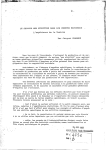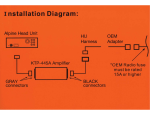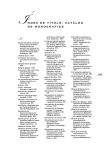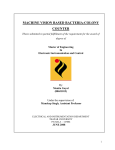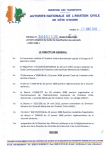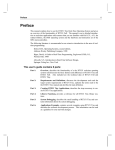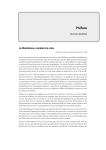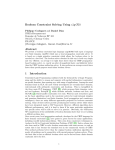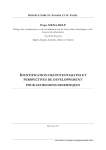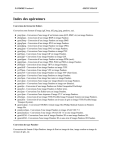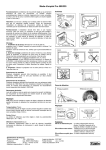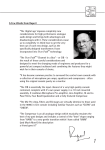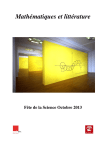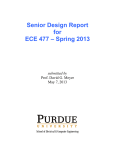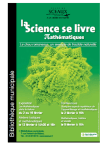Download n - Henry Story
Transcript
Sémantique,
effets de réseau
et métastabilité
Epineuil-le-Fleuriel
Henry Story
http://bblfish.net/
image thanks
Thursday, 20 September 12
Remerciement Stiegler.
Licence: CC Attribution
“Nur wo Leben ist, da ist auch Wille:
aber nicht Wille zum Leben, sondern
– so lehr ich's dich – Wille zur Macht!“
Also Sprach Zarathustra - Nietzsche
Thursday, 20 September 12
La vie comme volonté de puissance. En anglais “will to power” peut etre compris comme voloté de pouvoir, où le
pouvoir peut etre pensé comme pouvoir politique, ou pouvoir sur les autres. Mais cela devrait etre plutot compris
comme volonté de pouvoir d’action. Nietzsche parle de vie, et non d’individu. C’est a dire que c’est la vie entiere
qui doit etre compris comme cela. Qu’est ce que la vie? Des structures qui se reproduisent et qui doivent acceder
au plus de possibilités possibile. La plante pousse mais ne peut que lentement se déplacer. L’animal se deplace.
L’homme peut se changer et creer des outils qui lui permettent d’etendre sa puissance - l’avion pour aller plus
loin, l’ordinateur pour penser plus vite, les vaisseau spaciaux pour quitter la terre. Si il y a une necessité c’est
celle ci.
Also sprach Zarathustra
Ein Buch für Alle und Keinen
Thursday, 20 September 12
Beaucoup des livres de Nietzsche commencent avec ce genre d’avertissement. Zarathustra dit meme a ces
disciples d’aller leur propre chemin et de remetre questionier toujours ces pensées, de trouver d’autre chemins.
sceptre des hérauts
Thursday, 20 September 12
Nietzsche, qui était malade, malade disait-il de l’histoire Europeene, dont la syphilis attrapé tout jeune le
confronte avec la culpabilité, et dont les prédictions sur le 20e siecle et sur sa propre mésinterpretation ont été
entierement confirmé. Ce malade doit etre précéde de Hermes avec son caducet (porté par les hérauts officier qui
en tant de guerre passait porter les message et accompagnier les blessés.) Mais vers où le porter? Vers quel
hospital? Et quels outils utiliseront-ils pour le guerir?
Personellement j’ai choisi de me tourner vers la philosophie analytique comme antidote.
Thursday, 20 September 12
Philosophie analytique qui emerge en Allemagne, naissaint avec la révolution de la logique mathématique de
Frege a peut pres au même moment que Nietszsche est interné pour folie. Frege révolutionne la logique depuis
Aristotle, en la formalisant, la mathématisant, la préparant pour la mechanique symbolique de l’ordinateur qui
emergera dans le siecle suivant. Frége inspirera Bertrand Russel en angleterre, prendra Wittgenstein, Autrichien
comme élève et dont le Tractatus Logic-Philosophicus écrit pendant la premiere guerre mondiale, inspirera le
cercle de Vienne, qui furent chasse en grande partie vers les Etats-unis par le Fascisme.
“To be is to be the value
of a variable”
"...offends the aesthetic
sense of us who have a
taste for desert
landscapes."
Quine, 1948, "On What There Is"
Thursday, 20 September 12
Un de ces philosophes americains Quine (1908-2000), philosophe dit il lui meme des paysages desertiques,
embrace cet logique precise et la combine avec un “holisme” semantique. Je ne vais pas developer comme je ne
suis pas Quinéen. Mais par contre j’ai été beaoucoup influencé par ces deux éleves Donald Davidson, et en
particulier David Lewis, qui a pourrait on dire renversé cette pensée completement pour créer une des ontologies
les plus riches: celle des mondes possible.
The Web is now
philosophical
engineering.
Tim Berners Lee
Thursday, 20 September 12
C’est cette logique qui est deriere le Web Sémantique, le projet réel de Tim Berners Lee, et qui explique sa phrase
que le Web est de l’ingenieurerie philosophique.
WWW Geneva 94
Thursday, 20 September 12
graphes de relations entre des pages
Semantic Web
Thursday, 20 September 12
ces pages peuvent parler de choses dans le monde
Social Web
Thursday, 20 September 12
et donc mettre les choses elle même en relation a travers les page qui parlent d’elle a travers la relation
sémantique de référence.
5 Epoché/Revolutions
•
• Ordinateurs personells (thatcherisme)
• Web (et .com - Al Gore/Clinton )
• Web2.0 - l’aparition de social décentralisé
Web
Social
centralisé
(facebook,
twitter)
•
Micro-ordinateurs (et Arpanet)
Thursday, 20 September 12
2010: Privacy hits the headlines
Thursday, 20 September 12
un pharmakon qui a peut etre positif et négatif et qui nous amène Wikipedia, Facebook, et Wiki leaks.
Thursday, 20 September 12
Mais pour comprendre les réseaux actuels il faudrait faire un généalogie des sites de réseaux sociaux. Wired a
fait publie un excellent article sur The Well http://www.wired.com/wired/archive/5.05/ff_well_pr.html crée en
1984 et qui permettait des conversation tres poussé sur l’internet parmi les universitaires. Mais avec le .com
boom des sites basés beaucoup plus sur la pulsion sexuelle - sous la prétention de sites de rencontres se sont
crées.
Thursday, 20 September 12
Mais le probleme essentiel d’un site de rencontre est qu’une fois des gens se sont rencontrés, il ne veulent plus
utiliser le site. Le révolution de Facebook, bien loin d’agir sur les pulsions de bases comme le prétendent
beauoup, travaille en fait sur les relations a longue durée. En publiant l’image des personnes sur le site de facon
visible, en favorisant la notion d’amis stable, et d’amis d’amis, en favorisant une transparence FB a misé sur des
relations de transidividuation bien plus longue que les sites de rencontres. Cela permet évidement le court
termisme et la stupidité, mais l’architecture ne le renforce pas. Cela favorise en effet plutot que les gens
reviennent et échangent des données, en résolvant donc un probleme du web: celui de partage de contenu entre
amis.
Thursday, 20 September 12
derrière l’interface utilisateur des réseaux - des graphes de relations peuvent se former. Ces graphes sont
Facebook permet en plus la protection partielle des information, créeant des réseaux qui se policent eux memes
par leurs utilisateurs. Feacebook emprunte donc a wikipedia l’élement de “crowdsourcing” un policage du citeoyen de facebook par lui même.
Thursday, 20 September 12
Mais il permet aussi - quoique rarement discuté - la visibiltié de tout le réseaux par la corporation elle même.
Thursday, 20 September 12
corporation qui a été mis sur le marché a 100 milliards de dollards et qui depuis a perdus 60% de ca valeur, ce
qui risque de renforcer les mauvaises tendances pulsionelles dans le system.
Panopticon?
Thursday, 20 September 12
Jeremy Bentham
1785
Facebook est un panopticon capitaliste qui permet la visibilitée complete du systeme par les propiétaires, qui
peuvent dans les limites de l’acceptable (qui peut changer) vendre les données - ou meme etre oblige par les
pouvoirs politiques des etats unis de le réveler.
Thursday, 20 September 12
Comme dans l’ancient testament nous découvrons donc notre nudité totale. Et pourtant la question est: pourquoi
des milliards d’individus vont ils joindre de leur plein gré un system d’un tel genre? Comme dans l’ancien
testament nous devons comprendre la relation de Dieux au pouvoir. Et ici le pouvoir et compris dans l’éffet de
réseaux. Le plus de gens joignent facebook, le plus d’échangent ils peuvent faire facilement sur le systeme échange d’images, de sites web, le plus de confiance ils peuvent avoir, le plus confiance ils vont avoir et le plus
ils vont essayer de convaincre leurs amis de joindre. Echanger des photos de chats ou des videos par mail n’est
pas facile. FB résout ce probleme en donnant un semblant d’intime.
The Power Set is the sets of all subsets of a set.
P({A,B,C})={{},{A},{B},{C},{A,B},{A,C},{B,C},{A,B,C}}
|P({A,B,C})|=8
B
A
C
Thursday, 20 September 12
A bit of maths here is helpful. Take a set of three people: Allan, Beatrice, and Clive (A, B, C).
Consider the Power Set of that set, that is the set of all subsets of the set. It contains the empty set
the set of all singletons, the set of all pairs and the set itself. So the number of groups that can be formed
with 3 people is 8 as shown.
For a set of size n
the power set size is
n
2
Thursday, 20 September 12
Power sets follow a mathematical law: for a set of size n the power site size is 2 to the power of n.
It is worth looking at how this grows.
PS(100) = 1 267 650 600 228 229 401 496 703 205 376
PS(200) = 160 693 804 425 899 027 554 196 209 234 116 260
252 220 299 378 279 283 530 137
PS(1000) =
10 715 086 071 862 673 209 484 250 490 600
018 105 614 048 117 055 336 074 437 503 883 703 510 511 249
361 224 931 983 788 156 958 581 275 946 729 175 531 468 251
871 452 856 923 140 435 984 577 574 698 574 803 934 567 774
824 230 985 421 074 605 062 371 141 877 954 182 153 046 474
983 581 941 267 398 767 559 165 543 946 077 062 914 571 196
477 686 542 167 660 429 831 652 624 386 837 205 668 069 376
≈ 1 Googol cubed = (10^^100)^^3
Thursday, 20 September 12
The Power Set Size for 100 is 1 nonillion, for 200 it is one hundred sixty octodecillion.
To get an idea of the size of the Powerset of sets with 1000 members, we need to compare this number to the
Googol, the number of the famous search engine. A Googol is 10 followed by 100 zeroes. The third number has
300 digits, that is it is a google times a square google. So the space of possibilities we are looking at would be
like positioning a Google as one square in a space one googol long and one googol wide.
If we imagine 1000 acquaintances listing all the groups they are interested members of then, this is equivalent to
them declaring their position in this huge space of possibilities.
Well those are some back of the envelope calculations that would require some further thought.
Thursday, 20 September 12
Donc revenons a Hermes et au Caducae.
Pour résoudre ce probleme nous devons reconsidere encore une fois les problemes de l’architecture du web pour
bien monter comment cela
Thursday, 20 September 12
Consider the telephone network for example.
Thursday, 20 September 12
Calling across network operators does not seem to be a problem there.
Metcalf’s Law:
n(n − 1)/2,
which is proportional to
n2
Thursday, 20 September 12
It may have been at one point though. But the following reasoning can show us the pressures that are thought to
have been brought to bear in that space.
Consider a time where only two telephones were connected by one line. The value of the line would be completely
dependent there on the value those two people laid on their ability to communicate with each other remotely.
Consider now a network of 5 telephones. With 5 telephones the value of the telephone for each user is the value
he puts on communicating remotely with any of 4 other people. The value of the network is the combined
number of such connections, namely 10.
With 12 people in the network the value of the network is 11 for each user and so 66 for the whole network.
--- Notes --I first argued this in “RDF and Metcalf’s Law”, July 29 2006
http://blogs.sun.com/bblfish/entry/rdf_and_metcalf_s_law
French Population =
ML(65 million)=
65 million
2
2 080 million
German Population =
82 million
2
ML(65 million)=
3 321 million
German+French Pop = 147 million
2
ML(147)=
10 731 million
Thursday, 20 September 12
Imagine now that a country such as Germany and France were totally disconnected islands. The value of the
German network would be according to current population 2 080 million squared (quadrillion), the value of the
French network would be 3300 quadrillion links. By laying one cable linking the German and French network,
both the German and French networks gained millions of users, but more interestingly the combined value of the
network is double the value the sum of the two.
This gives an indication of the value advantage for any telecom operator to be part of a global
telecommunications space. It used to be argued that most people would find nearly no value in connecting out of
their local community, and so that these figures should not be taken too far. But more and more we are finding
that those links, once in place do get used... When spaces of possibilities open up, organisations develop to start
making use of them.
Thursday, 20 September 12
In any case one can now call people from any operator to any other operator, without ever really knowing what
operator one’s contact is on.
tel:+33.9.70.44.86.64
Thursday, 20 September 12
All one needs to know is their telephone number, a globally unique identifier for their phone. In some countries
one can even switch operator and keep the same number.
Thursday, 20 September 12
The same is true of e-mail.
In the early 80ies, when universities were starting to connect with each other, the value of e-mail was still very
limited. Even academics who could with minimal effort get email accounts often found the inconvenience of
learning new tools to participate in this network not to be worth their while.
mailto:[email protected]
Thursday, 20 September 12
But now with email you can send messages to the whole world, whatever organisation your contact belongs to,
wherever they are.
Again e-mails rely on globally unique identifiers, identifiers of inboxes that are easy to write down at a party and
type in a message. Nobody needs to know which software runs the resulting system, or who runs it. E-mail was
designed for cross organisational communication.
Thursday, 20 September 12
Now Consider the Web, you can buy your own domain name ( mine is bblfish.net ) and so can your friends...
bblfish.net
jack.name
juliet.name
bank.com
romeo.name
Thursday, 20 September 12
Imagine all of us get a computer and name each of our boxes using DNS (Domain Name System). The computers
could be anywhere: in the cloud, in your basement (of if you are Swiss in your bunker), in a pocket sized personal
computer devices, in your cell phone, .... whatever. We don’t care. We just draw them as boxes.
Eben Moglen: author of GPL
Freedom in the cloud
Thursday, 20 September 12
Libre =/= gratuit Stallman
Thursday, 20 September 12
Boite de Pandore.
Imagine all of us get a computer and name each of our boxes using DNS (Domain Name System). The computers
could be anywhere: in the cloud, in your basement (of if you are Swiss in your bunker), in a pocket sized personal
computer devices, in your cell phone, .... whatever. We don’t care. We just draw them as boxes.
Thursday, 20 September 12
On each of these you can set up your own web server which then allows others to access your web site with a
URL such as mine http://bblfish.net/
You then can place web pages on each of these servers. Any number of them. They can then be linked.
http://lemonde.fr/
reference
lemonde.fr
variant
variant
28 Aug 2000
20 Oct 2010
http://lemonde.fr/
Thursday, 20 September 12
Synchronie/Asynchronie -> nous amènera vers la diachronie
URI est le concept au coeur du system. C’est ce qui permet le creation de systemes distribués: parce que chaque
companie, chaque individu peut acheter un nom de domaine et ne pas avoir a synchroniser avec un objet central.
Cela permet le developmenet en parallel de pages. Mais comment c’est uri peuvent elles etre utilisés? Comment
ce
metastabilisent-ils?
blogs.sun.com
juliet.name
nicecupoftea.org
https://
nicecupoftea.o
rg/
bblfish.net
bank.com
lemonde.fr
variant
28 Aug 2000
variant
http://lemonde.fr/
Thursday, 20 September 12
20 Oct 2010
Thursday, 20 September 12
Donc revenons finalement a David Lewis et ca these doctorale de David Lewis sur la Convention pulblié en 1969
et qui comme vous pourrez le voir sur le site plato.stanford.edu a été discuté en profondeur pendant les 40
dernieres années.
Convention
•
• quand on raccroche le téléphone, qui rapelle?
• Hume: deux personnes rament sur un bateau
• de quel coté faut-il conduire?
quel
commodité
utiliser
comme
bien
d’échange
•
la rencontre de deux (ou plus de) personnes
Thursday, 20 September 12
Tous ces exemples vont etre réunis par Lewis et interprété par la théorie des jeux. La théorie des jeux a été
surtout utilisé a cet époque pour analyser les jeux de conflits, mais explique t’il la théorie des jeux s’applique
aussi bien au problémes de coordination, ou l’important est de trouver des equilibres entre le désir d’agents qui
vont amener a un systeme métastable.
Choix de point de rendez-vous
1.5
meet
1.5
.2
.5
.5
.5
.2
1.2
.5
.0
0
meet
0
1.2
.2
.2
0
1
meet
1
Thursday, 20 September 12
Imaginons par exemple que deux personnes veulent se rencontrer. Ils peuvent se rencontrer a plusieurs endroits
differents, et ce n’est pas tellement important où ils se rencontrent. Le meilleur endroit pour moi d’aller c’est
d’aller ou tu veut aller, et pour toi d’aller la ou je vais aller. (c’est un probleme de coordination)
il ne faut pas prendre trop au serieux les nombres ici. Ce sont
p.42 of Convention
A regularity R of the behavior of members of a population P when
they are agents in a recurrent situation S is a convention if and only
if, in any instance of S among members of P
(1) everyone conforms to R
(2) everyone expects everyone else to conform to R
(3) everyone prefers to conform to R on condition that others do,
since S is a coordination problem and uniform conformity to R is a
proper coordination equilibrium in S
Once the process gets started, we have a metastable selfperpetuating system of preferences, expectations, and actions
capable of persisting indefinitely.
Thursday, 20 September 12
Aberlard “senso composito”/”senso diviso” qui permet de reformuler le system dessus en terme ou les individus
n’ont pas necessairement besoin d’etre conscient de ces désirs.
Thursday, 20 September 12
(this is a book cover not licences under CC I believe)
Linking across sites is a trust issue that fragilises the publisher/speaker/agent (to use a term coined by the
psychoanalyst/painter Bracha Ettinger) by making her dependent on the behaviour of other players in the space,
but also strengthens her if the trust is rewarded. This is the same in any social endeavour from playing music, to
building bridges, to marriage, to shopping, to electing presidents, as John Searle emphasises so well in his latest
book “Making the Social World, The Structure of Human Civilisation”. The Web as a communication mechanism,
can be no other than social, since language and civilisation itself is thus.
Speaking of Searle. He is the author of the famous “Chinese Room experiment” where he imagines himself in a
room receiving symbols from the outside and manipulating it by following a set of purely syntactical rules, by
following a huge rule book, in such a way that the reply he returns would count as a good answer in Chinese. As
he points out in his online 2010 lectures, the key point is that Turing Machines are purely syntactical machines.
But there is something striking here: the Web is a set of interconnected machines, Turing machines perhaps? just
processing symbols. Yet the web does clearly have a minimal semantics: a browser can fetch a document placed
on a server on the other side of the world; documents link to each other; ...
It could be argued, and I think Searle would argue, that it is we who give those machines their semantics, by
tying them into large telecommunication structures, that follow carefully established protocols, which form
expectations on which actors start basing themselves. It is quite staggering when we think of just how big some
of these human built structures are, how much knowledge and coordination they involve. It is clearly with the
purpose of referring to things that URLs are built, this is how web developers think of them when using them, this
is what people think when clicking on a link. That behind this the turing machines just shift bits and bytes while
reductionistically true, may also make things suddenly seem very mysterious. Similarly explaining human
behaviour in terms of Neuron firing may at times be useful, but mostly not that helpful in everyday life.
REST as “Speech”/Document Acts
https://bblfish.net/
reference
bblfish.net
https://bblfish.net/
GET / HTTP 1.1
Content-Type: text/html
<html><body><h1>Henry Story</h1>
Thursday, 20 September 12
John Searle book, builds on his work on Speech Acts. The human world he argues there is built coordination
which is only possible at such a scale because of language and its use. As we are looking at the web we can
perhaps see something similar here. At least it may help us open up some new ways of thinking of it.
First we can think of all computers on the Web as agents in so far as they can issue and respond to requests.
The interfaces used on the Web are particularly simple ones, which is what enabled this system to grow so quickly
to the scale it has. The main Speech/Document act is the GET request, whereby one computer agent asks
another one for a REPRESENTATION of a resource.
Consider for example a Browser in the illustration above (also known as a User Agent) requesting the web page
http://bblfish.net/ . To do this the User Agent opens up a TCP connection to port 80 of the bblfish.net machine
and issues the request “GET / HTTP 1.1” followed usually by some further metadata describing the capabilities of
the browser. The Server bblfish.net running an Apache httpd daemon perhaps - there is a lot of other software
implementing the protocol - looks up the file in the file system, or generates one on the file from data in a
relational database and returns the HyperText Markup file preceded by a few headers of which the most
important perhaps is the mime type of the content, which enables the browser to select both the correct parser
for it and to determine how to display or use the information. The html usually has pointers to further embedded
images which will then be fetched the same way. Even a document on the Web is not just one file, but a graph of
interlinked documents!
Client/Server are roles, which any agent can play, speech acts
https://bblfish.net/
reference
jack.name
bblfish.net
https://bblfish.net/
GET / HTTP 1.1
Content-Type: text/html
<html><body><h1>Henry Story</h1>
Thursday, 20 September 12
There is nothing in the HTTP protocol that specifies that the client has to be a laptop and the server a machine
without a User Interface. The Client/Server distinctions are just roles that computer agents play in the protocol.
To make this clear I have here replaced the laptop with a box, which could be the same laptop, or another server.
Search engines after all follow exactly the same protocol to crawl the web for information before handing their
discoveries to indexing software.
https://bblfish.net/
bblfish.net
https://bblfish.net/
sense
reference
Thursday, 20 September 12
The Web as we have described it up to now has consisted only of URIs referring to resources that have been some
form of what is known as Information Resource - also known more commonly as a Document. In the case of URI
referring to a document, the sense of the document is given by interpreting the document. So the Sense/
Reference distinction that we get from Gottlob Frege, who revolutionised our understanding of Logic at the end of
the 19th century, and on which Bertrand Russel, Wittgenstein, the Vienna circle and essentially the whole of the
20th century analytic tradition of philosophy based their work, these two relations have up to know been coextensive.
--- Notes --For a lot more details on Frege see “Frege's contribution to the Philosophy of Language” by Richard G. Heck and Robert May
http://frege.brown.edu/heck/pdf/published/FregeContribution.pdf
rfc3986: “The fragment identifier component of a URI allows indirect identification of a
secondary resource by reference to a primary resource and additional identifying information.
The identified secondary resource may be some portion or subset of the primary resource, some
view on representations of the primary resource, or some other resource defined or described
by those representations”
https://bblfish.net/#hjs
bblfish.net:443
reference
https://bblfish.net/
sense
Henry Story
foaf:name
birthdate
29-July-1967
#hjs
Thursday, 20 September 12
The Semantic Web is one step forward on what is known as the Web of Documents, in that it permits the Sense/
Reference distinction to be made and used by taking advantage of a feature of the URI that has been hidden from
view until now: the fragment identifier. RFC 3986, which defines the URI has this to say: “The fragment identifier
component of a URI allows indirect identification of a secondary resource by reference to a primary resource and
additional identifying information. The identified secondary resource may be some portion or subset of the
primary resource, some view on representations of the primary resource, or some other resource defined or
described by those representations”. It is this later feature of fragment identifiers that is used by the semantic
web: The reference of a URI with a fragment identifier can be defined or described by the representation returned
by the document referred to by the URL without the fragment identifier. In the case illustrated here, the URL
“http://bblfish.net/#hjs” refers to me via the meaning of the document http://bblfish.net/
RFC 3986: http://www.apps.ietf.org/rfc/rfc3986.html#sec-3.5
Thursday, 20 September 12
So now that we have the reference relation, we can explain what is semantic about the Semantic Web. Semantics
is the relation that ties URIs to their referent, the relation that ties strings to things we might say, or words to the
world. Syntax on the other hand is the way names for things or properties can be combined to produce what are
known as well formed sentences or documents.
In the case of the semantic web we just need to imagine the world composed of things and binary relations
between things. Here we have in the Photo which I took a few years back in Berlin two people Richard and Anja,
related by one relation. This relation is the relation named by the URI http://xmlns.com/foaf/0.1/knows . So the top layer of three successive URIs forms an RDF sentence. These are just strings. The relation in the
world is what is satisfies the sentence according to this interpretation. The relation between the words and the
world (again a binary relation!) is what semantics is about.
This may seem very weird btw. We know that computers are very good at manipulating symbols. How do they
get this relation to the world? How do they get Semantics? Do they really need this relation? Why this extra layer
that seems to parallel the syntactic one? I will try to disentangle the magic here. But don’t let it entangle you.
Human beings find it quite easy to distinguish words and the world, and understand that relation very well. After
all the string for Anja in the picture is 47 characters long and as opposed to Anja never had a mother, and never
saw Berlin.
--- Reference --Picture first published in “syntax and semantics the relation between xml and rdf”, Dec 10, 2005
http://blogs.sun.com/bblfish/entry/the_relation_between_xml_and
foaf: friend of a friend
Thursday, 20 September 12
With this in place it now becomes possible to link not just documents, but also to related people via those
documents into machine readable social networks distributed across servers. Juliet can publish information about
herself as well as relationships of various kinds (friendship, kinship, etc) that she has with other people across the
web. These in turn can confirm those relationships by publishing profiles linking back to Juliet’s via what we can
call her WebID.
https://bblfish.net/
bblfish.net
https://bblfish.net/
sense
reference
Thursday, 20 September 12
The Web as we have described it up to now has consisted only of URIs referring to resources that have been some
form of what is known as Information Resource - also known more commonly as a Document. In the case of URI
referring to a document, the sense of the document is given by interpreting the document. So the Sense/
Reference distinction that we get from Gottlob Frege, who revolutionised our understanding of Logic at the end
of the 19th century, and on which Bertrand Russel, Wittgenstein, the Vienna circle and essentially the whole of
the 20th century analytic tradition of philosophy based their work, these two relations have up to know been coextensive.
https://bblfish.net/#hjs
bblfish.net:443
reference
https://bblfish.net/
sense
Henry Story
foaf:name
birthdate
29-July-1967
#hjs
rfc3986: “The fragment identifier component of a URI allows indirect identification of a secondary resource
by reference to a primary resource and additional identifying information. The identified secondary resource
may be some portion or subset of the primary resource, some view on representations of the primary
resource, or some other resource defined or described by those representations”
Thursday, 20 September 12
The Semantic Web is one step forward on what is known as the Web of Documents, in that it permits the Sense/
Reference distinction to be made and used by taking advantage of a feature of the URI that has been hidden from
view until now: the fragment identifier. RFC 3986, which defines the URI has this to say: “The fragment identifier
component of a URI allows indirect identification of a secondary resource by reference to a primary resource and
additional identifying information. The identified secondary resource may be some portion or subset of the
primary resource, some view on representations of the primary resource, or some other resource defined or
described by those representations”. It is this later feature of fragment identifiers that is used by the semantic
web: The reference of a URI with a fragment identifier can be defined or described by the representation returned
by the document referred to by the URL without the fragment identifier. In the case illustrated here, the URL
“http://bblfish.net/#hjs” refers to me via the meaning of the document http://bblfish.net/
Thursday, 20 September 12
So now that we have the reference relation, we can explain what is semantic about the Semantic Web. Semantics
is the relation that ties URIs to their referent, the relation that ties strings to things we might say, or words to the
world. Syntax on the other hand is the way names for things or properties can be combined to produce what are
known as well formed sentences or documents.
In the case of the semantic web we just need to imagine the world composed of things and binary relations
between things. Here we have in the Photo which I took a few years back in Berlin two people Richard and Anja,
related by one relation. This relation is the relation named by the URI http://xmlns.com/foaf/0.1/knows . So the top layer of three successive URIs forms an RDF sentence. These are just strings. The relation in the
world is what is satisfies the sentence according to this interpretation. The relation between the words and the
world (again a binary relation!) is what semantics is about.
This may seem very weird btw. We know that computers are very good at manipulating symbols. How do they
get this relation to the world? How do they get Semantics? Do they really need this relation? Why this extra layer
that seems to parallel the syntactic one? I will try to disentangle the magic here. But don’t let it entangle you.
Human beings find it quite easy to distinguish words and the world, and understand that relation very well. After
all the string for Anja in the picture is 47 characters long and as opposed to Anja never had a mother, and never
saw Berlin.
Thursday, 20 September 12
So let us now consider how the Address Book works in a bit more detail. Let us imagine we have two servers on
the web one by Tim Bray one of the authors of the RDF/XML spec, a famous blogger, and semantic web skeptic,
and one by me. Let us imagine that one day Tim Bray will give up his skepticism and just use the semantic web
by publishing his foaf profile in some document such as the one shown here, which is a readable non XML
notation knows as Turtle a subset of N3. The two documents describe two people and link them by the knows
relation. Clearly there are no arrows going from one server to the next. The link is made by the use of URIs of
course.
Thursday, 20 September 12
But there is no harm in picturing the documents as two graphs that link to each other as shown here. Each
person is described by his relationship to a few other resources, be it an openid a telephone number or a name.
And each graph links each primary topic of the graph - that is Tim Bray on the left - to the primary topic of the
graph of the other graph via the foaf:knows relation.
Named Graph Store
Henry
Tim
foaf:name
foaf:name
foaf:knows
:tim
:fetched-at
:from
foaf:knows
1 April 2008
http://ongoin.org/tim.rdf
:me
1 April 2008
http://bblfish.net/people/henry/card
:fetched-at
:from
Thursday, 20 September 12
What the Semantic Address Book does is to fetch those two graphs using the HTTP protocol, which it then stores
in a semantic database (knows as a quad store) whilst adding metadata on the graph relations themselves. That
is the semantic database makes sure it can keep track of where and when it found the information.
Named Graph Store
Henry
Tim
Henry
sun
sun
ongoing
http://sun.com
+33 ...
1 April 2008
http://ongoin.org/tim.rdf
http://sun.com
1 April 2008
http://bblfish.net/people/henry/card
Tim
http://ongoing.org/
a
+33 (0)164225952
NetworkedGraph
rules
Thursday, 20 September 12
The Address Book can then merge the information from the two graphs to produce a new merged graph. Where
one could not ask what the name of the friends of the primary topic were in the original mini graphs, one can do
this now. Here one can ask for example what Henry’s friends’ names are using a query language such as SPARQL.
The answer here will be “Tim”. By merging the graph we deepen our ability to query data, we can explore a larger
network and we can discover new relations that were not available in either of them alone. The Power of the
Semantic web lies exactly here: it is one could say the mathematics or logic of information merging. Everything in
the semantic web is designed to make this easy: from the simple relational data structure, to the open world
assumption, to the URI reference distinction.
Named Graph Store
bblfish
Henry Story
foaf:nick
http://bblfish.net/
foaf:name
http://bblfish.net/
foaf:openid
foaf:blog
owl:sameAs
<http://bblfish.net/#hjs>
<http://bblfish.net/people/henry/card#me>
:fetched-at
:from
1 April 2010
http://bblfish.net/
1 April 2010
http://bblfish.net/people/henry/card
:fetched-at
:from
Thursday, 20 September 12
This merging of information can help us understand even more clearly the importance of reference on the
semantic web from a computational perspective.
Imagine for example that our Address Book had found the following two graphs on the web, each of them
making an identity claim. The owl:sameAs relation is this identity relation. From the law of indiscernibility of
identity it follows that the object, however named must have all the properties truly asserted of it.
Named Graph Store
http://bblfish.net/people/henry/card#me
bblfish
http://bblfish.net/#hjs
refers_to
foaf:nick
refers_to
http://bblfish.net/
foaf:blog
Henry Story
http://bblfish.net/
foaf:name
foaf:openid
Thursday, 20 September 12
The merged graph therefore can merge the relations from both graphs onto the object referred to by the two
URIs. Clearly the two URIs are distinguishable. They have different number of characters for one. Their referent is
therefore clearly different from the URI. It is the referent of the names that is what gets merged.
The concept of reference is therefore essential to making merging of information possible. And since merging
information is what allows the powerful network effects to take place, it is an essential tool of thought.
Growing the Social Web
Thursday, 20 September 12
So we are right at the beginning of the Social Web now. The need for it has become clear in the past year, and
people are speaking of Personal Data Stores, me of a Social CMS. We are then in a very similar situation where Tim
Berners Lee was in 1990 when he showed off the first Web Browser: he was the only one with a some content,
and he needed to get the network to grow.
Thursday, 20 September 12
To see that these metaphors of growth has a much deeper relevance than one may think, let me summarise this
fascinating work by Ruth Garett Millikan, “Language, Thought and Other Biological Categories”. All her papers
are online by the way on her web site.
--- Notes and References --I first developed the points described in the following section on April 2006 in “UFO’s seen growing on the Web”
in response to a debate where the issue was how the semantic web could get going. The argument was that it
needed an Upper Foundational Ontology but since it was impossible to get agreement on that, it was also
impossible for the web to get going.
Millikan’s web site: http://www.philosophy.uconn.edu/department/millikan/
“UFO’s see Growing on the Web” April 06, 2006
http://blogs.sun.com/bblfish/entry/ufo_s_seen_growing_on
“Names and memes” July 26, 2006
http://blogs.sun.com/bblfish/entry/names_and_memes
“Language is a Virus” Sept 09, 2007
http://blogs.sun.com/bblfish/entry/language_is_a_virus
Thursday, 20 September 12
R. Millikan starts her book by asking what the distinction is between the physical and the biological. What is the
Categorical difference between atoms and life.
Thursday, 20 September 12
(Picture owned by HP - I guess)
To start her analysis she considers a well known device: the photocopier. The function of this machine is to make
copies of paper. The relation between the original paper and the new one is not a relation of material identity
since we end up with two papers. The function of the photocopier is to produce a copy of a certain pattern: the
patterns of text on the entry page. “A pattern has been reproduced” she writes “if its form is derived from a
previous item or items having, in certain respects the same form, such that had the model(s) been different in
these respects, the copy would have been different accordingly”.
Where it is easy to find the function of a mechanical device such as the photocopier, since we constructed it,
and it comes with a user manual, it is not quite so easy to find the proper function for those structures in the
world that have arisen by themselves: namely living beings. Since there is no user manual for living beings, which
are clearly reproducing themselves Millikan asks how one can find the direct proper functions of parts of an
organism such as the heart, the eye, etc... After considering different options she considers the statistical
correlation. Perhaps the function of the heart pumping blood is because statistically that is what it does the most.
This does indeed sound right in the case of the heart.
Thursday, 20 September 12
(Copyright unknown)
But the counterexample is just too strong. In the case of sperm and eggs, perhaps the two most fundamental elements in the
evolution of most species, the statistical chance of a sperm succeeding in fertilizing an egg is close to zero. This leads Millikan to
propose that the primary function of an organism is determined by the evolutionary role that function played in the history of that
organism. Since Millikan described the notion of function in terms of the notion of reproduction and evolutionary history, and she
places the Biological with the category of that which reproduces, this allows her to extend these thoughts to areas that may have
previously seems dissimilar.
In particular she can then extend these notions to Language. Language can be thought of as composed of a generative syntax
which guides the combinations of a finite set of words to produce ever new sentences. The generative syntax in humans can be
thought of as being naturally selected for if we believe Chomsky. The words used in a language on the other hand are
conventional, and they reproduce between each member of a language community as part of the sentences of which they are part.
The function of the words may be many but for many words one important function is the referential function. If I someone shouts
“careful! Bus!” the word “Bus” refers to a big heavy vehicle. In a world where people use the word as we do then at least in cases
such as this it will have a direct relevance to the life of the person who hears it, as it should trigger them to turn their head and
step back. That is the meaning of the words is in part independent of either the speaker or the hearer, though without of course a
pattern of use in a community the word would have no meaning at all.
So with this conception which will remind some of the work on Memes by Richard Dawkins, Millikan has in book made some
fundamental moves. First she has naturalised and historicised the philosophy of language. Analytic philosophy had until then
suffered from an a-historical because too logical view of the world. By adding evolution, Millikan shows how the etymology of a
word is key to understanding its meaning. Secondly she reminds us that there have to be reasons for words to spread from brain
to brain. Each person needs to find an advantage in participating in the spreading of the word, which spreading reinforces the use
of the word. But very importantly Milikan has also show how the relation of reference between a word and the world can be
achieved even if it is not achieved in the minds of every participant that uses the word, as for example many people know
something about “HIV” but could not distinguish it from any other disease if asked.
There may also be here something for people studying Derrida a french philosopher, who wrote a lot about texts to look at.
From what I understand from one book by Geoffrey Bennington, Derrida was very aware of the historical nature of words, how
when written they were to be read later by many people, many of whom would be unknown to the author, written perhaps to be
read after his death. This led Derrida to notice that texts are things that survive over time and whose meaning is partly altered with
every reading which in some way escapes them. Indeed if language belongs to the Biological Category, that is the category of those
things which follow the logic of reproduction, then Millikan may have found a way for french and analytic philosophy to find
another meeting point, perhaps with the added advantage that Millikan can give an explanation also of reference, and so tie the
word back to the world.
what are the components?
• Software reproduces
• Vocabularies reproduce
• They reproduce each other
• Selection of vocabularies
• Value of network effect
Thursday, 20 September 12
(Picture given out with Keynote.app by Apple)
So with such an understanding of language we can explain the final part of how the Social Web can grow in a
distributed decentralised way. In a decentralised World Wide Web there can be no Académie du Web that orders
and defines the meanings of URLs on the Web. Such an organisation would be a huge bottleneck, and it would be
impossible in a global space. But if there is no central authority, only relative trusted authorities such as the W3C,
then how do we avoid a massive duplication of vocabularies on every subject? Who gets to decide which the good
vocabularies are? Well in the end I want to suggest it is simply natural selection of vocabularies. This natural
selection occurs in a number of ways, which are not that different from how HTML and the web got going in the
first place. Vocabularies appear in documents that are read by software, which can then publish new documents
for others to link to (in the case of the WWW the navigators did not publish, but html was easy enough for people
publishers to learn by themselves). If doing this increases the value to the user of the software tool he is using
while increasing the value of the network even more then the vocabulary (the URIs, html) will spread in the web
and so will the software too. As these networks grow in value, any new software tool that consumes the
vocabulary will find it more advantageous to work with the old vocabulary rather than create a new one to do the
same thing, as it will then surf along with the growing movement that already exists. For a vocabulary to
maximise it’s adoption it has to minimise any friction to its duplication: patent free, copyright free licences help a
lot here, and so does truthfulness and trust in the institutions publishing core vocabularies - a place for
universities, which are some of the longest established institutions in the world, to play a leading roles.
Conclusion
• The Web is a declarative P2P architecture built on
URIs
• Reference enabled both linking and merging of
information
• Network effects is the driving force
• WebID enables agent identification in a subjective
web of trust
Thursday, 20 September 12
So in conclusion of this very long talk. We saw how behind the web, in the social web and in the linked data and
semantic web the network effect is a driving force that allows these distributed peer to peer, biological like
systems to grow and stabilise. Currently these network effects are working in favour of some very big providers,
but their inability to link out is imprisoning their users and in the longer term themselves too. A much wider
space of possibilities is available in a global social web allowing players from health agents to government
institutions to political players to businesses to work together in a decentralised way, protecting each actors
privacy in the process, as well as allowing them each to express their point of view without enforcing a point of
view on the system as a whole. It is on the foundations of the URI, the global identifier, that the network effect
can take place, by tying sense and reference together and enabling information linking and merging at a global
scale.
Identity is social.
http://bblfish.net/
Thursday, 20 September 12
Identity is in a very strong way social, and of course the social is very much tied to identity. This should not come
as a surprise. There is a lot more to be said certainly but the best is to leave this open for further exploration and
discussion on the web.
Also as a final note I recommend “Logicomix” a great cartoon that covers the birth of 20th century analytical
philosophy and logic.
http://www.logicomix.com/


































































